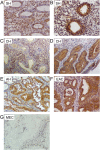PRMT5 promotes progression of endometrioid adenocarcinoma via ERα and cell cycle signaling pathways
- PMID: 33416213
- PMCID: PMC7869932
- DOI: 10.1002/cjp2.194
PRMT5 promotes progression of endometrioid adenocarcinoma via ERα and cell cycle signaling pathways
Abstract
Protein arginine methyltransferase 5 (PRMT5) has previously been reported to be upregulated in many malignant tumors. This study investigated the significance of PRMT5 in endometrial carcinoma (EC) and explored its function in tumorigenesis. Immunohistochemistry was performed to evaluate PRMT5 expression in 62 EC and 66 endometrial hyperplasia samples. The functions of PRMT5 were investigated by cell counting kit-8, plate colony formation, wound healing, and transwell and flow cytometry assays. Quantitative reverse transcription-polymerase chain reaction and western blotting were used to measure the expression of PRMT5, changes in estrogen receptor α (ERα), and related functional proteins. Coimmunoprecipitation was performed to examine the interaction of PRMT5 with ERα and its coactivator steroid receptor coactivator-1 (SRC1). Compared to endometrial hyperplasia tissue, PRMT5 was overexpressed in endometrioid adenocarcinoma (EAC) but not overexpressed in mucinous EC. The main expression pattern of PRMT5 in EAC was cytoplasmic. However, the positive cases of endometrial hyperplasia showed both cytoplasmic and nuclear positivity in the endometrial glands or were mainly positive in stromal cells. Knockdown of PRMT5 significantly inhibited the growth and migration ability of EAC cells and promoted their apoptosis by regulating cyclin D1, c-myc, p53, and Bcl2 proteins. Furthermore, PRMT5 could form a complex with ERα and SRC1 to promote the expression of ERα. In conclusion, PRMT5 plays a significant role in the progression of EAC by interacting with ERα and impacting the cell cycle signaling pathways.
Keywords: ERα; PRMT5; cell function; endometrial cancer; epigenetics.
© 2021 The Authors. The Journal of Pathology: Clinical Research published by The Pathological Society of Great Britain and Ireland & John Wiley & Sons, Ltd.
Figures




Similar articles
-
Oestrogen receptor-mediated expression of Olfactomedin 4 regulates the progression of endometrial adenocarcinoma.J Cell Mol Med. 2014 May;18(5):863-74. doi: 10.1111/jcmm.12232. Epub 2014 Feb 4. J Cell Mol Med. 2014. PMID: 24495253 Free PMC article.
-
Tumor-associated macrophage-derived CXCL8 could induce ERα suppression via HOXB13 in endometrial cancer.Cancer Lett. 2016 Jun 28;376(1):127-36. doi: 10.1016/j.canlet.2016.03.036. Epub 2016 Mar 24. Cancer Lett. 2016. PMID: 27018308
-
Estrogen receptor beta (ERbeta) in endometrial simple hyperplasia and endometrioid carcinoma.Appl Immunohistochem Mol Morphol. 2008 Dec;16(6):535-42. doi: 10.1097/PAI.0b013e31816755a9. Appl Immunohistochem Mol Morphol. 2008. PMID: 18931615
-
The Role of WDR77 in Cancer: More than a PRMT5 Interactor.Mol Cancer Res. 2025 Apr 1;23(4):269-276. doi: 10.1158/1541-7786.MCR-24-0933. Mol Cancer Res. 2025. PMID: 39853175 Review.
-
The Role of PRMT5 in Immuno-Oncology.Genes (Basel). 2023 Mar 9;14(3):678. doi: 10.3390/genes14030678. Genes (Basel). 2023. PMID: 36980950 Free PMC article. Review.
Cited by
-
The circSPON2/miR-331-3p axis regulates PRMT5, an epigenetic regulator of CAMK2N1 transcription and prostate cancer progression.Mol Cancer. 2022 May 27;21(1):119. doi: 10.1186/s12943-022-01598-6. Mol Cancer. 2022. PMID: 35624451 Free PMC article.
-
Chitosan oligosaccharides packaged into rat adipose mesenchymal stem cells-derived extracellular vesicles facilitating cartilage injury repair and alleviating osteoarthritis.J Nanobiotechnology. 2021 Oct 26;19(1):343. doi: 10.1186/s12951-021-01086-x. J Nanobiotechnology. 2021. PMID: 34702302 Free PMC article.
-
Integrative Evaluation of the Clinical Significance Underlying Protein Arginine Methyltransferases in Hepatocellular Carcinoma.Cancers (Basel). 2023 Aug 20;15(16):4183. doi: 10.3390/cancers15164183. Cancers (Basel). 2023. PMID: 37627211 Free PMC article.
-
Roles of estrogen receptor α in endometrial carcinoma (Review).Oncol Lett. 2023 Oct 25;26(6):530. doi: 10.3892/ol.2023.14117. eCollection 2023 Dec. Oncol Lett. 2023. PMID: 38020303 Free PMC article. Review.
-
Therapeutic targeting of protein arginine methyltransferases reduces breast cancer progression by disrupting angiogenic pathways.Biochem Biophys Rep. 2025 Jul 31;43:102172. doi: 10.1016/j.bbrep.2025.102172. eCollection 2025 Sep. Biochem Biophys Rep. 2025. PMID: 40791817 Free PMC article. Review.
References
-
- Siegel R, Naishadham D, Jemal A. Cancer statistics, 2012. CA Cancer J Clin 2012; 62: 10–29. - PubMed
-
- Balch C, Matei DE, Huang TH, et al Role of epigenomics in ovarian and endometrial cancers. Epigenomics 2010; 2: 419–447. - PubMed
-
- Bokhman JV. Two pathogenetic types of endometrial carcinoma. Gynecol Oncol 1983; 15: 10–17. - PubMed
-
- Piulats JM, Guerra E, Gil‐Martin M, et al Molecular approaches for classifying endometrial carcinoma. Gynecol Oncol 2017; 145: 200–207. - PubMed
Publication types
MeSH terms
Substances
LinkOut - more resources
Full Text Sources
Other Literature Sources
Research Materials
Miscellaneous

